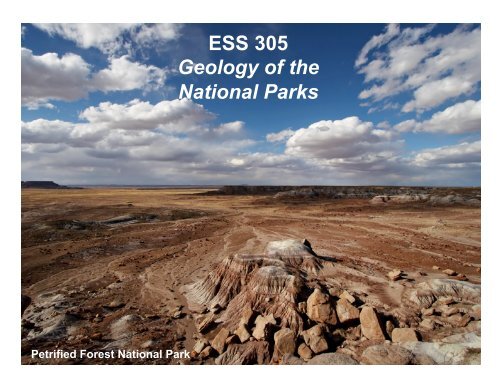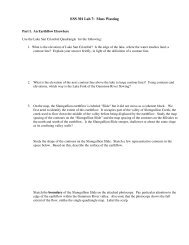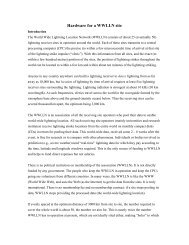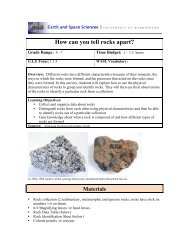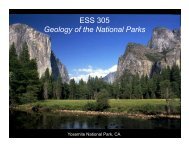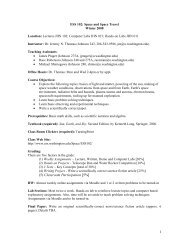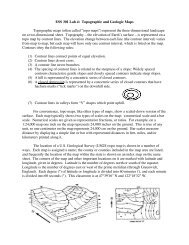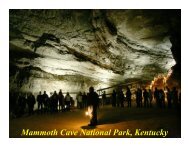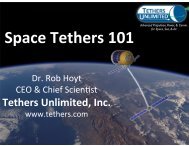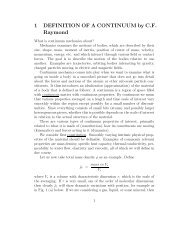Time, Cratons, and Voyageurs NP
Time, Cratons, and Voyageurs NP
Time, Cratons, and Voyageurs NP
- No tags were found...
Create successful ePaper yourself
Turn your PDF publications into a flip-book with our unique Google optimized e-Paper software.
Today’s Lecture• Geologic <strong>Time</strong>• Dating Techniques– Relative Dating– Absolute Dating• Formation of Continental <strong>Cratons</strong>– Metamorphic <strong>and</strong> Igneous RocksPetrified Forest National Park
• Twoaspectsoftime:Geologic<strong>Time</strong>– Relativetime(oldervs.younger),arrangementintoasequence.Geologically,mostlybasedonsedimentaryrocks.– Absolutetime(quantitative),specificationofduration.Geologically,mostlybasedonigneousrocks.• Thegeologictimescalewasfirstdevelopedusingtheprinciplesofstratigraphy<strong>and</strong>faunalsuccession,thetwobasesofrelativedating.Absolutedatingbecamepossiblewiththelaterunderst<strong>and</strong>ingofspontaneousradioactivedecay.
PrinciplesofStratigraphy• OriginalHorizontality:Manyrocks,particularlysedimentary,aredepositedashorizontallayers.• Superposition:Youngermaterialisdepositedontopofoldermaterial.• Cross‐CuttingRelations:Features(faults,dikes,etc.)whichcutlayersareyoungerthanthoselayers.• Inclusion:Objects(clasts,fossils)inasedimentarylayerareolderthanthelayeritself.• Unconformities:Lengthy“gaps”intherockrecordmaybeidentifiedbythearrangementoflayers.
The Principle of Original Horizontality states that sediment in nearly all environmentswill be deposited in essentially horizontal layers. Many volcanic rocks also formhorizontal layers. Departure from horizontality indicates subsequent distortion.
Layered sedimentary rock is typically deposited horizontally, but can be deformedby tectonic processes. Tilting is a mild example of this. A structure like this oftenrepresents the local exposure of large-scale folding.
When sedimentary layers are encountered in a folded configuration, it is inferred thatthey were distorted after their originally horizontal deposition.
The Principle of Superposition states that younger sedimentary rock layers will befound above older sedimentary rock layers, unless the rock units have beenoverturned after deposition.
The Principle of Uniformitarianism states that the “present is the key to the past.”Those processes operating at Earth’s surface today are inferred to have operatedsimilarly in the past, such as the mudcracks forming in a playa lake today.
The mudcracks shown above formed over 1.1 billion years ago in a dry lake basinin what is now Montana.
Raindrop impressions are preserved in 1.1 billion year old sedimentary rocks inthe Belt Group rocks of Montana.
The Principle of Cross-Cutting Relations permits us to conclude that the fault whichcuts across <strong>and</strong> offsets these layers is younger than the layers themselves.
As an example of several generations of cross-cutting relations, the older glacialsediment is offset by a younger fault. The fault, in turn, is cut by a younger road.Based on this principle, which is older: the alluvial fan at the lower left or the road?
Complex sequences of events can be sorted by examining cross-cuts.
The Principle of Inclusion states that any included bodies will be at least somewhat olderthan the rock containing the inclusion. In this case, the clasts are older than the age ofdeposition for the conglomerate which contains them.
Unconformities• NosinglelocationonEarth’ssurfacehasbeenasiteofuninterrupteddepositionthroughoutallofEarth’shistory.Instead,interruptions<strong>and</strong>episodesoferosionhaveproduced“gaps”intherockrecord,oftenofsignificantduration.• Thesegapsarerecognizablebytheunconformitiestheyproduced.Suchrecognitionisnecessaryforproperinterpretationofevents.• Consequently,inordertopiecetogetherasmuchofEarth’shistoryaspossible,evidencefrommanylocationsmustbecompared<strong>and</strong>correlated.
TypesofUnconformities• Nonconformity:Sedimentisfoundimmediatelyaboveintrusiveigneousormetamorphicrock.Indicateslengthyerosionbeforesedimentationoccurred.• AngularUnconformity:Olderlayersarefoundatanangletoyoungerlayers.Indicatestilting<strong>and</strong>erosionbeforesedimentationresumed.• Disconformity:Youngsedimentisfoundimmediatelyabovemucholdersediment,withanerosionalsurfaceinbetween.Indicateserosionoccurredbeforesedimentationresumed.
Intrusive igneous rocks <strong>and</strong> metamorphic rocks form atgreat depth. Any adjacent sediment which was present atthe time of their formation invariably will have been“cooked” by the heat which was present. Therefore,“uncooked” sediment next to such rocks must have beendeposited after the intrusive or metamorphic body wasexposed via erosion. This takes time; this interval of time isnot represented by any rock which is present, but isindicated by the nonconformity itself.Similarly, tilted (folded) sediments which are interrupted byan erosional surface also indicate a lengthy period of“missing” time which passed before the resumption ofsedimentary deposition. The younger sediment indicatesthe “new” horizontal l<strong>and</strong>scape.Finally, sediments of much different age are occasionallyfound in direct contact. (Note that their ages must beestablished by comparison with relatively uninterruptedsequences elsewhere.) Close inspection of the contactbetween the layers often reveals signs of an erosionalsurface, indicating again that a lengthy period of erosionremoved part of the rock record at this location.
Granite with overlying sediment. The granite must have formed as an intrusion <strong>and</strong>crystallized by shedding its heat into the surrounding rock. This sediment, however,shows no signs of having been cooked in this way, so the granite must have beenexposed at Earth’s surface by erosion, then covered again by this sediment, producing anonconformity. As a bonus, a dike cuts across both. How old (relatively) is the dike?
Note the abrupt interruption of thesedimentary layers at the lower partof this photo. The orientation of theupper (younger) layers is quitedifferent.Angular unconformities occur due totilting/folding followed by erosionalepisodes <strong>and</strong> perhaps long periodsof non-deposition prior to theresumption of deposition, often in avery different sedimentaryenvironment.
James Hutton interpreted this angular unconformity at Siccar Point in Scotl<strong>and</strong> in1785 <strong>and</strong> used it as evidence for uniformitarianism <strong>and</strong> for an old Earth.
Both “sides” of this angular unconformity are now tilted. If deposition were toresume here, yet another angular unconformity would be produced.
Aren’t all bedding planes(surfaces between layers)actually disconformities,then?Arguably yes, but it is moreuseful to restrict the term tothose instances where it canbe demonstrated that anunusually long interval oftime is “missing” at thatpoint.Before the advent ofradiometric dating, this wasexclusively done usingfossils <strong>and</strong> the Principle ofFaunal Succession.But first, an example....
The Gr<strong>and</strong> Canyon has several unconformities recognized within its rock record.
Five well-known unconformities are shown on the above cross-section of the Gr<strong>and</strong>Canyon. Ignore the numbers (for now); these relationships instead were establishedusing the principles already mentioned.
FaunalSuccession<strong>and</strong>Correlation• WilliamSmith(late1700s)observedthatfossilswerefoundinrocksinaspecificsequencewithinoldertoyoungerlayers.Thiswasusefulforidentifyingtherelativeageofnewly‐identifiedmaterial.• Mostusefulareindexfossils,whichrepresentspeciesthatwereabundant<strong>and</strong>widespread,butonlyforashortperiodoftime.• Overlappingrangesofindexfossilspermitevennarrowerdeterminationsofage.
Brachiopods (lamp shells) are marine invertebrates which superficially resemblebivalves (clams) even though they are not closely related. Some groups, such as theLingulata, have been present throughout the Phanerozoic. Others, however, such asObolellida, have restricted ranges.If a rock contains an assemblage of more than one group, such as both Pentamerida<strong>and</strong> Spiriferida, this limits its possible age to the narrower span when both coexisted.
Correlation of rock units over greatdistances becomes much moreconvincing if those rocks sharesimilar fossil assemblages. Here,a limestone exposed at the top ofthe Gr<strong>and</strong> Canyon has beenidentified as the same materialfound near the base of Zion.Similarly, a s<strong>and</strong>stone at Zion isalso exposed at Bryce Canyon.Oftentimes it is possible toestablish correlation on the basisof similar lithologies (rock types)<strong>and</strong> similar sequences of layers,but one could argue that theseenvironmental conditions maysimply have occurred at differenttimes in different places.
Geologic<strong>Time</strong>Scale• Bythemid‐1800s,geologistshadcorrelatedtheworldwidepatternoffossilrangesinsufficientdetailtoestablishatimescalefortheentireplanet.Thisscaleremainsvalidaftermorethan150yearsofcontinuedfieldresearch.• Thetimescaleisbasedonthestratigraphicpositionsofmajorchanges(extinctions)inthefossilrecord.Itishierarchical:majortimeperiodsaresubdividedonthebasisofminorchanges.
Divisionsof<strong>Time</strong>Scale• Eons(largestdivision):– Phanerozoic(“obviouslife”),rockswithobviousfossils– Precambrian(earlierthanCambrian),nowsubdividedintoProterozoic(“firstlife”),Archean,<strong>and</strong>Priscian• Eras– Cenozoic(“newlife”),organismssimilartomodern– Mesozoic(“middlelife”),suchasdinosaurs– Paleozoic(“oldlife”)• Periods• Epochs
Absolute<strong>Time</strong>• Oneimmenselyfrustratingaspectofrelativetime:Howlongagoweretheseevents?• Manyestimatesweremadebasedonmodernsedimentation<strong>and</strong>erosionalrates,butresultsvariedwidely.Unconvincing.Neededaclock.• Withthediscoveryofspontaneousradioactivefission(decay)ofnaturally‐occurringisotopes,coupledwiththerealizationthattheratesofdecayweremeasurable<strong>and</strong>apparentlyconstant,aclock(severalclocks,actually),becameavailable.
SpontaneousRadioactiveDecay• Someisotopes(atomswithaparticular#protons<strong>and</strong>#neutrons)areunstable<strong>and</strong>willfallapart.• Exactlywhenanyparticularatomwillundergofissionisunpredictable,butthebehavioroflargenumbersofidenticalatomswillfollowastatisticalpattern,analogoustoflippingcoins.• Thenumberofunstableatoms,called“parents,”willdecreaseinapredictablefashion,producing“daughter”atoms.Theratioofparentstodaughterswillindicatehowmuchtimehaspassed.
Age EquationD = Do + N(e ⎭t -1)D= number of daughter atomsN = number of existing parent atomsD o = number of initial daughter atomse = exponential function⎭⎭= decay constantt = timeRadioactive isotopes will decay spontaneously to form daughter atoms.Radioactive decay is exponential <strong>and</strong> constant. Different radioactive elements willhave different decay rates, but the shape of the curve describing their abundanceswill be the same (shown as blue curve).
RadiometricDatingofRocks• Inordertobeusefulforabsolutedating,theisotopemustoccurinrocksinmeasurablequantities.Wecanmeasuresmallamounts,buttherearelimits.• Therockmusthavebeensealedagainstgainorlossofmaterialatatimeofinterest(suchasthesolidificationofamagma).Thislimitstheselectionofvalidc<strong>and</strong>idates.• Allnaturalprocesseswhichproduceaspecificdaughtermustbeknown<strong>and</strong>considered.
WhatEventsCanBeDated?• Forigneousrocks,itisconvenienttouseasysteminwhichthedaughterisaninertgas(suchasPotassium‐Argondating),sincedaughteratomswilleasilyescapeuntilsolidificationoccurs.The“clock”startswhenthemagmabecomesrock.• Formetamorphicrocks,the“clock”willberesetiftemperatureswerehighduringmetamorphism.Therefore,ageofmetamorphismisdetermined.• Forsedimentaryrocks,theageofindividualclastscanbemeasured,butnottheageofdeposition.
Potassium-Argon dating can be used to date potassium-rich basalt flows that exceed300,000 years in age.
K-Ar dating was utilized to assign chronology of early hominid finds in northernEthiopia. Paleomagnetic data can be used to fill in gaps within the chronology.
The steep front of this Hawaiian basalt flow represents an ice-contact front. Thebasalt flow abutted against glacial ice <strong>and</strong> its K-Ar age provides constraints on thetiming of glacial advance on the Big Isl<strong>and</strong> of Hawaii.
One short-lived isotope is 14 C, alsoknown as C-14 or radiocarbon. “Normal”carbon is 12 C <strong>and</strong> is not radioactive.Since 14 C has a half-life of only 5730years, it “should” be nearly all gone,except that more is continuously beingmade in Earth’s upper atmosphere byhigh-energy radiation causing neutrons tosmash into 14 N, converting it to 14 C.Any living organism which exchangesCO 2 with the atmosphere will have a ratioof 14 C to 12 C which is controlled by theamount of 14 C in the air. Upon death,however, the continuously decaying 14 C isno longer replenished.Radiocarbon dating is useful indetermining the age of organic materialup to about 70,000 years, with carefulmeasurement.Useful for archaeology <strong>and</strong> some aspectsof recent geology.
Organic samples are prepared for radiocarbon dating by combusting or dissolvingthe organics <strong>and</strong> producing CO 2 gas. The decay activity in the CO 2 gas will bedirectly related to the time of death (age) of the organic material.
Radiocarbon dating is useful for assigning ages to sediment that may incorporateorganics during erosion <strong>and</strong> deposition, such as this log present in glacial till.
Radiocarbon dating is useful for assigning ages to young (
Radiocarbon dating is useful for capturing contrab<strong>and</strong> made from endangered species,such as this whale bone carving. Is this fresh (illegal) or fossil (legal) bone material?
OtherAbsoluteMethods• Severalothernaturalprocessesaresufficientlyregularthattheycanbeusedtocounttime.Afewexamples:– Dendrochronology:countingtreerings– Varves:countingseasonallayersinlakesediments– Lichenometry:measuringlichengrowth– Cosmogenicexposure:cosmicraydamagetoexposedsurfaces
Dendrochronology: Trees produce annual rings. Significantly, these rings vary inwidth depending on local climate. This can be used to correlate trees of overlappingages, so a continuous record can extend back further than the age of any single tree.
Varves: Lakes which freeze overduring their winters will have alternatinglayers of thick, light-colored sediment(summer) <strong>and</strong> thin, dark-coloredsediment (winter). The dark layers arerich in organic material which wasburied before it could rot or otherwisebe consumed. Events which interruptthis regular sedimentation, such asl<strong>and</strong>slides, can be dated by countinglayers.
Lichenometry: Lichens are symbiotic coloniesof algae <strong>and</strong> fungus which exp<strong>and</strong> across asurface slowly with time, depending on localclimate. Comparison of growth on nearbysurfaces of known age (such as buildings) willpermit the determination of unknown ages,such as rockslides.
Cosmogenic (surface) dating: If a rock surface was initially exposed to the air during anevent of interest (such as this glacially-scoured surface), then the amount of damage tothe surface from incoming high-energy radiation (cosmic rays) will indicate how long agothe exposure occurred, thereby dating the event (in this case, glaciation).
Earth’s Crust…
Formation of Continental <strong>Cratons</strong>Metamorphic <strong>and</strong> Igneous Rocks• Continental cratons largely formed in the Archean (>3.5 Ga)– Earth's heat flow nearly 3 times higher than it is today– Mantle was much more fluid <strong>and</strong> the crust much thinner
AGE OF NORTHAMERICANBASEMENTROCKS(Billions Years)Rocks are oldestnear the center ofthe continent(continental shield)<strong>and</strong> tend to beyounger outward.Marshak, EARTH(Norton, 2005)Parks <strong>and</strong> Plates©2005 Robert J. Lillie
Terrane AccretionMarshak, EARTH (Norton, 2005)Parks <strong>and</strong> Plates©2005 Robert J. Lillie
Formation ofContinental <strong>Cratons</strong>Metamorphic <strong>and</strong>Igneous Rocks
Pillow basaltscraped off theocean floor duringterrane accretionTerrane AccretionIgneous RocksMarshak, EARTH (Norton, 2005)MetamorphosedRocksParks <strong>and</strong> Plates©2005 Robert J. Lillie
North America in the Early Cambrian (560 Ma)Marshak, EARTH (Norton, 2005)Sedimentary Rocks
NORTH AMERICAN CONTINENT~500 Million Years AgoParks <strong>and</strong> Plates©2005 Robert J. Lillie
<strong>Voyageurs</strong> National Park,Minnesota
<strong>Voyageurs</strong> National Park• Established April 8, 1975• Interconnected northernlakes• 40 miles long <strong>and</strong> 3-15miles wide
<strong>Voyageurs</strong> National ParkHolocene History• “Red Paint People”– Pictographs painted on rock cliffs– 8000 years old• 1600-1800– Route of French-Canadian <strong>Voyageurs</strong>600 Miles
<strong>Voyageurs</strong> National ParkRecent History• Gold mining in 1893-1898– Difficult to transport ore in <strong>and</strong> out ofthe area, so this didn’t last.• Regional interest in preserving <strong>and</strong>protecting the waterways.– First attempt to establish a nationalpark was in 1891.
<strong>Voyageurs</strong> National ParkGeologic History• Archean (>2.6 Ga; Early Precambrian)– Intensely metamorphosed sedimentary,volcanic, <strong>and</strong> intrusive igneous rocks
<strong>Voyageurs</strong> National ParkGeologic History• Early Proterozoic (~2.5 Ga)– Evidence for early tectonics• Kenoran Orogeny – earliestrecognized in US– Metamorphic Rocks» Gneiss (forms at ~10miles depth)» Greenstone belts
<strong>Voyageurs</strong> National ParkGeologic History• Early Proterozoic (~2.5 Ga)– Evidence for early tectonics• Kenoran Orogeny – earliestrecognized in US– Metamorphic Rocks• Igneous Rocks– Plutons» Gneiss (forms at ~10miles depth)» Greenstone belts– Batholiths– Dikes
<strong>Voyageurs</strong> National ParkAn example of the evolution of the continental cratonMarshak, EARTH (Norton,2005)
<strong>Voyageurs</strong> National ParkGeologic History• Late Proterozoic to Pleistocene (2.1Ga – 1.8 Ma)– Minor intrusions 2.1 Ga– Has been “stable” since thenWhy are the deep roots ofmountains exposed? Iserosion enough?NationalParkService
<strong>Voyageurs</strong> National ParkGeologic History• Isostatic Rebound
<strong>Voyageurs</strong> National ParkGeologic History• Pleistocene (1.8 Ma to present)Marshak, EARTH (Norton, 2005)<strong>Voyageurs</strong><strong>NP</strong>


